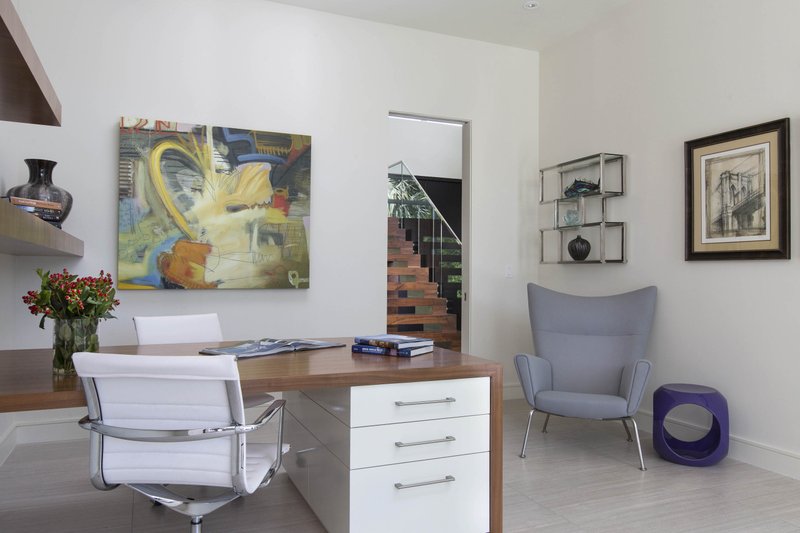Should I get a birthday cake? My husband asks. One of our kids was coming over with his family to celebrate his birthday. (We'd all been sheltering in place, so this get together was a tiptoe back to quasi reality for us.)
"Uh, no," I say, then play out the scene: "Here, blow your breath really hard all over this cake, then we'll serve everyone a piece. The days of birthday cakes and candles are over."
DC ponders this. "That's a good point."
Like many women running households, I now have a new role: germ police. All of the following sentences have flown out of my mouth over the last two months: Don't touch that! Where have your hands been? Leave that outside. Don't go to the store; we will make do. Wash up. How much toilet paper do we have? I need some fresh air.
While no one can foresee all the ways home life post-covid will change, minimizing the spread of germs will certainly be the chief goal. To get a glimpse into how that might translate into homes of tomorrow, I spoke to two forward-looking designers: architect and home builder Phil Kean, of Winter Park, Fla., and Donald Strum, head of product design for Michael Graves Architecture & Design, of Princeton, N.J. Together we identified 15 likely features of the post-covid home:
• Hands-free fixtures — Expect to see more of anything that does not require hands to activate. That includes motion- or foot-activated faucets, automatic flush toilets, motion-sensitive doors, and voice-activated TV remotes and sound systems. "We already have hands-free refrigerators and voice-activated coffee makers," Kean said. "More will come."
• Keyless entries — Soon, more of us will be opening doors with our phones, or with infrared detection systems.
• More sinks — Now that handwashing has become a constant, a half-bathroom or just a sink near a home's entrance will become fairly standard.
• Smart toilets and bidets — Ever since The Great Toilet Paper Shortage of 2020, the popularity of bidets and smart toilets has soared and will continue to, Kean said. Today's smart toilets retrofit to work with existing commodes, so they function as bidets, too.
• Hands-free trash cans — Your doctor's office had it right, Strum said. Step-operated trash cans with self-closing lids will become standard in homes, too.

• Nonporous surfaces — Because they are easier to disinfect, plastic cutting boards and nonporous counters will replace wood and butcher block in kitchens.
• Better yards — Whether a better-outfitted backyard or front porch, outdoor spaces will get more attention, as folks confined to their homes crave sunlight, fresh air, a change of scenery, and the opportunity to share a socially distant "quarantini" with neighbors and friends.
— Home vegetable gardens will also gain ground, as people try to become more self-reliant, said Strum, who has doubled the size of his own home garden.
• Fewer open floor plans — While big open spaces and great rooms have been popular, many homeowners have rediscovered the importance of doors, whether to get some work done or just to get some space. Privacy is trending.
• Dedicated workspaces — The pandemic has driven more telecommuting, and much of that is likely to stick. "We will be rethinking spaces to make sure that those working at home have an office away from household disruptions and that kids also have a quiet dedicated place to do schoolwork," Kean said.
• Zoom zones — Homes today suddenly need Zoom appeal. Thus, having a designated, publicly presentable space for teleconferencing that doesn't capture dirty dishes or unmade beds, and that minimizes yapping pets and noisy kids, will become de facto. "Now if only someone could do something about the landscapers who show up with their blowers and mowers during important phone calls," Strum added.
• More food storage — Food-hoarding during the pandemic has given way to a desire for more pantry and freezer space. Bigger, better pantries will address our need to store more nonperishables, so we feel more secure. Future homes will likely also have more freezer space to store perishable food.
• Delivery rooms — "We need to change the way we accept deliveries, so we don't have to meet the delivery person," said Kean, who imagines homes having a giant drop box, or maybe a room adjacent to the house. The area should have a way to directly discard packaging into outdoor waste receptacles.
• A shift to the suburbs — The pandemic has raised concerns about close living, driving up interest in housing away from densely populated cities, experts say. As our homes have had to serve as offices, classrooms, gyms and isolation rooms, and as college kids have come home for extended stays, and as we've witnessed the impact that communal living has had on nursing homes, home buyers are going to be looking for more room to house our pastimes and our extended families, Kean said. The desire for more house coupled with fewer workers commuting to jobs will also drive a move to the suburbs, where you can buy more house for less money.
• A cupcake comeback — And, yes, years from now we will view the act of blowing out dozens (well, in my case) of candles on a birthday cake as high-risk behavior, up there with hugging and shaking hands. My bet is we'll see more cupcakes, and that birthday celebrants will need to make a wish and blow out candles stuck in something we don't eat.
Mea culpa — In last week's column on ceiling fans, I got the information about fan-blade spin backward. If you are looking up at your fan, blades should turn counterclockwise in warm months.
Syndicated columnist Marni Jameson is the author of five home and lifestyle books
HomeStyle on 06/06/2020
